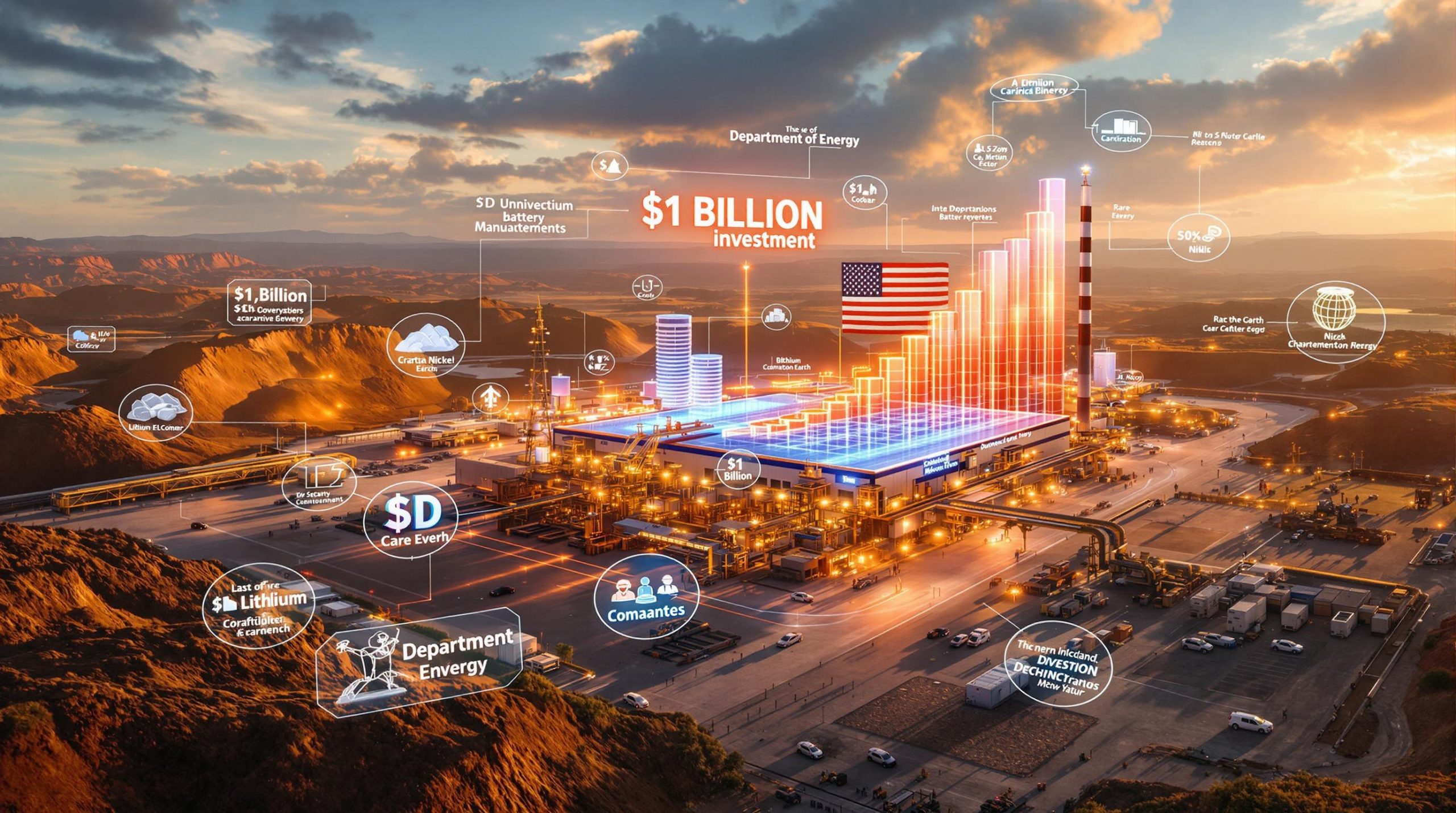BHP Reports Record Copper Output While Jansen Potash Project Faces Challenges
BHP Group has achieved unprecedented copper production levels in its latest operational report, setting new benchmarks for the mining giant. This record output comes amid growing global demand for copper, driven by renewable energy transitions and electrification trends worldwide.
Record-Breaking Copper Production
BHP's copper output reached an all-time high of 328,000 tonnes in Q2 2025, demonstrating the company's strategic focus on expanding its copper portfolio. This exceptional performance reflects successful operational improvements and strategic acquisitions that have strengthened BHP's position in the global copper market.
The mining giant's strategic acquisition of OZ Minerals has significantly contributed to this record output, adding the Prominent Hill, Carrapateena, and Carajas operations to BHP's copper assets. This acquisition has boosted BHP's copper price insights by approximately 5% year-on-year, reinforcing its position as one of the world's leading copper producers.
"High-grade copper mineralisation confirms strategic value in tier-1 acquisitions," noted Gino D'Anna, Askari Metals Executive Director, highlighting the operational synergies achieved in copper asset integration.
The Prominent Hill mine in South Australia has been particularly noteworthy, contributing to a 15% quarterly output increase post-acquisition. These operational enhancements included optimized extraction processes and improved resource management at the integrated OZ Minerals sites.
Jansen Potash Project Setbacks
Despite copper success, BHP's ambitious Jansen potash project in Canada is experiencing significant setbacks that could impact the company's diversification strategy. The project timeline has been extended beyond the original 2026 target, with capital expenditure increasing to $7.5 billion from the initial estimate of $5.7 billion due to technical complexities.
"Jansen's delays stem from geotechnical hurdles in evaporite basin drilling and regulatory compliance costs," explained Ian Lyall, Proactive Managing Editor. The challenges include brine inflow management in Saskatchewan's Elk Point formation and shaft-sinking precision requirements.
The financial implications of these delays are substantial, with a 12-18 month ROI deferral. This postponement has notable consequences for BHP, potentially increasing development costs and delaying the anticipated revenue generation from potash production.
Similar challenges have affected other potash projects globally. Highfield Resources' Muga Potash Mine in Spain faced comparable delays due to aquifer mitigation issues, illustrating the industry-wide complexity of developing these resources.
BHP's Position Among Global Copper Producers
BHP's exceptional copper output positions it among the elite global copper producers, competing directly with industry leaders for market dominance. The latest global rankings for Q2 2025 place BHP as the second-largest copper producer worldwide:
| Producer | Q2 2025 Production | Year-on-Year Change |
|---|---|---|
| Codelco | 332,000 tonnes | ↓16% |
| BHP | 328,000 tonnes | ↑5% |
| Freeport-McMoRan | 324,000 tonnes | Not reported |
| Zijin Mining | 248,000 tonnes | Not reported |
| Glencore | 244,000 tonnes | Not reported |
Industry analysts note that "BHP's ascent to #2 reflects capital discipline in high-margin jurisdictions versus Codelco's aging Chilean assets." This competitive positioning strengthens BHP's influence in global copper markets and enhances its negotiating power with customers and suppliers.
BHP has achieved an all-in sustaining cost (AISC) of $1.45/lb, which compares favorably to the industry average of $1.62/lb. Meanwhile, Codelco's Chuquicamata mine has experienced decline due to ore grade depletion and labor disputes.
Factors Influencing BHP's Operational Performance
Multiple factors have contributed to BHP's record copper production, while different challenges affect its potash project development. The company has reported a copper EBITDA margin of 52% in Q2 2025, driven by $32.5 billion in renewable energy demand.
BHP has implemented significant operational enhancements across its copper assets. Machine learning algorithms for predictive maintenance at Escondida in Chile have reduced downtime by 23%, while real-time sensor networks at Olympic Dam in Australia have enabled a 17% throughput increase.
According to BHP's 2024 Annual Report, "Electrification-driven copper demand offsets potash timeline risks, ensuring portfolio balance." This market-driven approach has aligned with BHP's strategic focus on copper as a growth commodity.
The Jansen potash project delays highlight the complex challenges of developing large-scale mining industry trends in new commodity sectors. These challenges include technical complexities, regulatory requirements, and the integration of advanced mining technologies in a different geological context.
Implications for BHP's Future Strategy
BHP's contrasting performance in copper and potash development signals potential strategic adjustments for the mining giant. Copper is projected to constitute 45% of BHP's portfolio by 2030, up from 30% in 2025.
The success in copper production alongside challenges in potash development has influenced BHP to recalibrate its strategic priorities. Notably, $2 billion of Jansen Phase 1 capital expenditure has been reallocated to Escondida smelter upgrades.
"Copper's margin resilience prioritizes brownfield expansions over greenfield potash," according to BHP's CFO during a Q2 2025 investor call. Additionally, the Phase 2 Jansen feasibility study has been paused, with capital redirected to Quebrada Blanca Phase 2 in Chile.
BHP has demonstrated operational efficiency in its copper investment strategies, completing the OZ Minerals integration in 11 months versus the industry average of 18 months. These decisions will shape the company's production profile and revenue streams in coming years.
Despite the Jansen delays, BHP's commitment to entering the potash market represents a long-term diversification strategy to reduce dependency on traditional mining commodities. This diversification aims to position BHP for changing global resource demands and provide more stable performance across market cycles.
Impact on BHP's Sustainability Goals
BHP's operational results have significant implications for its sustainability commitments and environmental footprint. According to the International Energy Agency (IEA) 2024 report, one tonne of copper enables 7GWh of renewable energy generation.
The record copper production aligns with global decarbonization efforts, as copper is essential for renewable energy infrastructure, electric vehicles, and energy-efficient technologies. BHP's Sustainability Dashboard 2025 states that "Record copper output aligns with Scope 3 downstream decarbonization targets."
The Jansen potash project, despite its delays, incorporates design optimizations targeting 30% lower CO₂ per kg of K₂O compared to industry peers. Technical innovations include a zero-liquid-discharge design and carbon capture pilot for steam generation.
For comparison, Glencore's Collahuasi Mine reduced emissions by 22% via electrified haulage, and BHP is benchmarking similar technology for its operations. These environmental considerations provide BHP with additional time to enhance sustainable mining transformation and safeguards within the project design.
Significance for Global Copper Markets
BHP's record copper production has broader implications for global copper markets and supply chains. The company now supplies 8.5% of global copper, with industry forecasts predicting a deficit of 4.7 million tonnes by 2030 according to CRU Group 2025 analysis.
The impact on price stability is significant, with data suggesting a 10% output increase correlates with a 3.2% reduction in price volatility according to London Metal Exchange analysis. CRU Metals analysts note that "BHP's output stabilizes supply chains critical for Biden's 2030 EV targets."
BHP has secured strategic offtake agreements with manufacturers such as Siemens Energy, covering 35% of wind turbine copper demand. This additional copper supply contributes significantly to global supply stability, potentially helping to address market tightness and moderate price volatility.
The expanded production capacity comes at a critical time when copper demand is accelerating due to green energy transitions worldwide. Meanwhile, Freeport's Grasberg ramp-up has failed to offset BHP's market share gains in Asian OEM contracts.
Impact on BHP Investors
BHP's operational performance presents a mixed picture for investors, with strong copper results contrasted against potash project delays. Copper revenue has surged 29% year-on-year, while potash delays have cut FY26 EBITDA projections by $1.2 billion according to UBS Research from July 2025.
The dividend yield stands at an attractive 6.8%, secured by copper cash flow, compared to the sector average of 3.4%. UBS Mining analysts note that "Copper's supercycle fundamentals offset Jansen's execution risks for long-term holders."
From a technical perspective, BHP's project economics indicate that Jansen's NPV sensitivity shows a 12-month delay reduces IRR by 340 basis points. For comparison, when Rio Tinto's Oyu Tolgoi faced delays in 2022, it triggered a 15% share drop, but BHP's major copper system strength has prevented similar volatility.
Despite the Jansen delays, BHP's strategic positioning in both copper and potash markets offers investors exposure to commodities with strong long-term demand fundamentals. Copper demand is projected to grow with electrification trends, while potash remains essential for global food security through fertilizer production.
Frequently Asked Questions About BHP's Copper Production and Potash Project
What is driving the global demand for copper?
The global transition to renewable energy, electrification of transportation, and expansion of electrical infrastructure are creating unprecedented demand for copper. According to IEA data, copper's electrical conductivity makes it essential for solar panels, wind turbines, and electric vehicle manufacturing, with each EV requiring up to 83 kg of copper compared to 23 kg in conventional vehicles.
Why is BHP investing in potash through the Jansen project?
Potash represents a strategic diversification opportunity for BHP, providing exposure to agricultural markets through fertilizer production. Global food security concerns and population growth are driving long-term potash demand, with projections showing a 40% increase in agricultural output needed by 2050. This diversification helps balance BHP's portfolio against cyclical downturns in traditional mining commodities.
How do delays in the Jansen project affect BHP's competitive position?
While the delays postpone BHP's entry into potash production, the company's strong performance in copper helps maintain its overall competitive position in the global mining sector. The delay also allows BHP to refine its approach to potash production, potentially resulting in improved operational efficiency when production begins. The company remains positioned to be a significant player in the potash market despite the setback.
What are the environmental implications of BHP's copper production increase?
While increased mining activity has environmental impacts, copper's critical role in renewable energy technologies means BHP's production contributes to global decarbonization efforts. For every tonne of carbon emitted in copper production, 100-150 tonnes of CO₂ can be avoided through its use in renewable energy applications. BHP is also implementing sustainability measures across its operations to minimize environmental footprints, including water recycling, renewable energy, and habitat conservation initiatives.
Want to Invest in the Next Major Mineral Discovery?
Discover significant ASX mineral discoveries as they happen with Discovery Alert's proprietary Discovery IQ model, transforming complex mineral data into actionable investment insights. Explore why historic discoveries can generate substantial returns by visiting Discovery Alert's dedicated discoveries page and begin your 30-day free trial today to position yourself ahead of the market.




